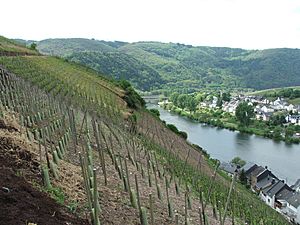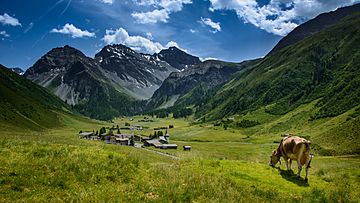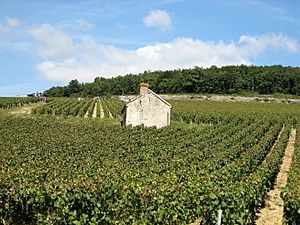Terroir facts for kids

Terroir is a French word that means "land." It describes all the natural things and human actions that affect how a plant grows and how its products taste. Think of it as the special character a place gives to the food or drink made there.
For example, terroir is studied for crops like grapes (for wine), coffee, olive oil, chocolate, and tea. It's about how the unique environment and farming methods make these products special.
In France, terroir is the main idea behind the "appellation d'origine contrôlée" (AOC) system. This system makes sure that products like wine come from a specific place and have a certain quality because of that place. It means the land where grapes grow gives them a unique quality. People in the wine world still discuss how important terroir really is.
Contents
How the Idea of Terroir Started
For hundreds of years, French winemakers noticed that wines from different areas, or even different parts of the same vineyard, tasted different. They started using the idea of terroir to explain these unique qualities that a place gives to its wine.
Long before the French, ancient civilizations also understood that different regions could make very different wines, even from the same grapes. The Ancient Greeks would mark their clay jars (called amphorae) with the seal of the region they came from. Some regions became famous for their high-quality wines.
Later, monks from the Benedictine and Cistercian orders in Burgundy, France, grew grapes for centuries. Because they owned a lot of land, they could carefully watch how different plots of land affected the wine. Some stories even say the monks tasted the soil! Over time, they wrote down their observations and marked the boundaries of different terroirs. Many of these boundaries are still used today for famous vineyards in Burgundy.
What Makes Up Terroir?
Experts might not agree on an exact definition, but they usually focus on natural things that humans can't control. A professor named Mark A. Matthews from University of California, Davis thinks the common idea of terroir is a bit of a myth. He agrees that local features affect how plants grow and how wines taste. However, he says the term isn't clearly defined and that people believe in it mostly because of old traditions, not strong scientific proof.
Things often considered part of terroir include:
- Climate: The weather patterns of a place.
- Soil type: What the dirt is made of.
- Geomorphology: The natural shape of the land.
- Other living things: Plants and tiny organisms around the crops.
The climate's influence on terroir can be looked at in different ways:
- The macroclimate is the general weather of a large area, like the Côte de Nuits region.
- The mesoclimate is the weather of a smaller part of that region, like a village.
- The microclimate is the weather right around a specific plant or row of grapevines.
The soil affects terroir by its makeup, how fertile it is, how well water drains, and how well it holds heat. Geomorphology includes natural features like mountains, valleys, and bodies of water. These features change how the climate affects the area. It also includes the direction a vineyard faces and its elevation (how high it is).
Other living things in the vineyards include animals (fauna), plants (flora), and tiny living things (microflora). The tiny living things (microbes) in vineyards are even thought to be a measurable part of the overall terroir.
Human Influence on Terroir
The idea of terroir can also include things that humans control or influence. For example, choosing which type of grape to plant is a human decision. However, whether that grape will grow well and make good wine is a natural part of terroir that humans can't fully control. Some grape varieties simply grow better in certain areas.
In winemaking, using wild yeast (found naturally) instead of lab-made yeast can show the terroir of a place. Using oak barrels is a debated topic. Some say oak helps bring out terroir flavors, while others argue it can hide them. How a vineyard is managed, like growing grapes organically or biodynamically, is also a human choice that affects terroir.
How Growing and Making Affect Terroir
Many choices made during the growing and winemaking process can either make the terroir more noticeable or less noticeable in the final product. These choices include how plants are trimmed, if they are watered (irrigation), and when the crops are picked (harvest).
At the place where the product is made, things like using oak, the type of yeast, how long the product sits with its skins (maceration), and the temperature during fermentation can all affect the terroir. Other processes like micro-oxygenation (adding tiny amounts of oxygen), chaptalization (adding sugar), clarification (making it clear), and reverse osmosis (filtering) can also change or hide the terroir characteristics.
Winemakers can choose to focus on making a product that truly shows its terroir, or they can make it without thinking much about terroir. Also, natural terroir elements like climate and soil are often considered when deciding which crop to plant, even if the goal is just to make a good product, not necessarily a "terroir-driven" one.
In France, especially in Burgundy, many believe that a winemaker's job is to help the terroir express itself in the wine. The French word for "winemaker," vigneron, means "wine-grower." This belief that terroir is the most important influence is why French wine labels often highlight the region, vineyard, or AOC more than the type of grape or the producer.
Climate Change and Terroir
Climate change is changing weather patterns, making temperatures hotter and causing more extreme weather. This could seriously affect terroir and the industries that rely on it.
Warmer temperatures can make grapes ripen faster, leading to higher sugar content and less acid. This also changes other compounds important for aromas. Growers are trying different ways to adapt. For example, in 2021, the Bordeaux region in France allowed winemakers to try growing new types of grapes from other parts of France. These new grapes can only make up a small part of the final product. The rest must come from the traditional grapes grown there for 2,000 years.
Another way to protect plants is to experiment with different rootstocks. This helps develop plants that are strong and use water better in tough conditions. Farmers are also studying new ways of planting, watering, and harvesting. Practices from warmer places like Australia and Spain are now being used in countries that used to be cooler, as temperatures rise.
Terroir in Other Foods and Drinks
The idea of terroir isn't just for wine. It's also important for other drinks like tea (Wuyi rock-essence tea is a good example) and Cognac. For Cognac, the chalky soil, climate, and distance from the ocean all affect the final product.
Producers of whiskey, bourbon, rum, and vodka also use terroir elements. For example, the flavors from barrel aging in wood are part of their terroir.
Terroir in Artisan Cheese

The idea of terroir also applies to making artisan cheese. French authorities have worked to balance the needs of traditional cheesemakers, who focus on terroir cheeses, with those of large companies.
The taste of cheeses (and other dairy products) is affected by where they are made. For instance, pastures in the Alps have more types of grasses, herbs, and flowers than those in lower areas. At higher elevations, the plants also change a lot from spring to autumn. This means the taste of cheeses made at different times of the year will also change. In Switzerland, "Alp cheese" often has a special logo, along with its "Appellation d'origine protégée (AOP)" label.
Protecting Unique Products with Appellation Systems
The influence of terroir means that products from a certain region are unique. They can't be exactly copied somewhere else, even if you use the same crop type and making methods. Winemakers in Burgundy believe they are making unique Burgundian wines that happen to be from Pinot noir grapes, not just Pinot noir grown in Burgundy.
Systems like the French AOC were created around the idea of "unique products from a unique area." These systems have also become "protected designation of origin" across the European Union. This means, for example, that winemakers outside of Tuscany can't make a Sangiovese wine and call it a Chianti. Even if they use the same type of Sangiovese grape, the same soil, and the same methods, it's assumed the two products will be different because of terroir.
The names of these European regions are protected so that products from different areas and different terroir are not confused. For example, you wouldn't call a Spanish or Australian product "Chianti." In the United States, there was some confusion over names like Champagne and Port. However, the American wine industry has made more effort to recognize that place names are uniquely connected to the products made there, like the 2005 Napa Declaration on Place agreement.
While these systems protect "unique terroir", the business importance of terroir has been much discussed. In Spain in 2018, groups of winemakers started a grassroots movement to make wines with added terroir value. They wanted to improve the Spanish rural wine culture.
Commercial Value of Terroir
The importance of terroir can affect the price of a product. Things like branding, the type of crop, and knowing the farmer who produced it can all influence the price. The Slow Food movement values the history of a plant or animal, the story of the farmer, and the quality of the product. Chefs and bakers also have their own ideas about the qualities they want, and terroir plays a role in this.
Some critics wonder if a Pinot noir wine from a famous Burgundy vineyard is really worth much more than one from a "lesser terroir" vineyard. They also question if the higher price is fair when the "lesser" vineyard might have better winemaking.
Critics also look at the difference between New World and Old World wines. They ask if modern winemaking methods – like using a lot of oak, very ripe fruit, special yeasts, or color additives – hide or even remove the influence of terroir. Critics often point out that mass-produced wines from popular types like Chardonnay can taste very similar, no matter where they come from, because their terroir is hidden by strong winemaking techniques. A heavily oaked, very ripe Chardonnay from California might taste a lot like the same style of wine from somewhere else.
The marketability of products from different regions is affected by how important terroir is seen by the industry and by consumers. Some producers even downplay terroir and its effect on their products.
Terroir Outside Europe
In the United States, the ideas of terroir have been used in a few specific cases. For example, Vidalia onions can only be called that if they are grown in a specific area defined by the United States Department of Agriculture. Similarly, Indian River fruit can only use that label if it's grown in an area defined by the United States Federal Trade Commission.
In some East Asian countries, terms like terroir have become popular, partly because of Japanese manga (comics). A 2008–09 Korean drama called Terroir was about a wine restaurant named after the concept.
Terroir in Popular Culture
The idea of terroir has been shown in several films and TV shows.
- Jonathan Nossiter's 2004 documentary, Mondovino, looks at how the wine business is becoming global. It includes interviews with small producers, mostly French, who talk about terroir.
- In the 2006 BBC series, Oz and James's Big Wine Adventure, one episode is mostly about Oz Clarke teaching James May about terroir. By the end, May successfully identifies three wines based on the quality of their terroir.
- Les Blank and Gina Leibrecht's 2007 documentary, All in This Tea, explores how important terroir and organic growing methods are for the quality and future of the Chinese tea market.
- Terroir is also a common topic in the Japanese wine comic Les Gouttes de Dieu.
- The films French Kiss and A Good Year also mention terroir.
- Recognizing terroir is a key plot point in the 1976 French comedy L'aile ou la cuisse (The Wing or the Thigh) with Louis de Funès.
- In 2014, Keith Carradine starred in John Charles Jopson's film Terroir, which was inspired by Edgar Allan Poe.
See also
 In Spanish: Terroir para niños
In Spanish: Terroir para niños


